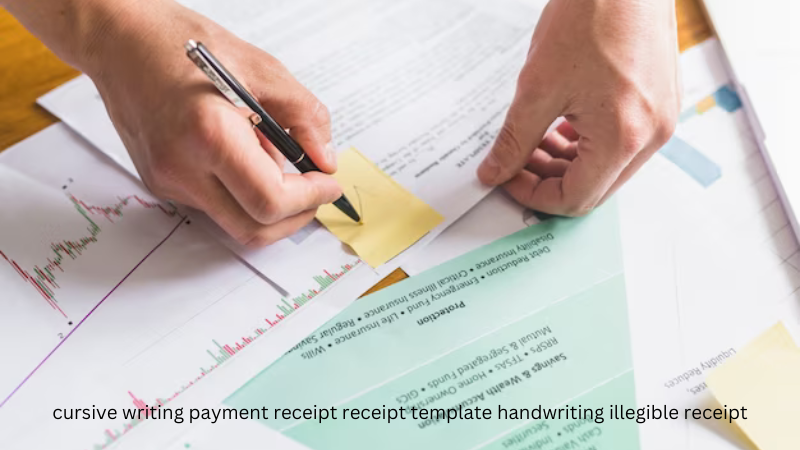What is Cursive Writing?
Cursive writing is a style of penmanship where letters are connected, allowing for faster writing. Originating in the 16th century, it has evolved through time, showcasing various styles and forms. Unlike print writing, which features distinct, separate letters, cursive flows together, creating a more fluid and artistic appearance.
The Role of Cursive Writing in Payment Receipts
Payment Receipt Essentials
A payment receipt must contain several essential components: the date, the amount paid, the names of the parties involved, and a description of the transaction. Clarity is paramount; if a receipt is difficult to read, it can lead to disputes and misunderstandings. Thus, achieving a balance between cursive flair and legibility is crucial.

Common Cursive Styles for Receipts
Various cursive styles can be employed when creating receipts. From classic copperplate to more modern scripts, each style brings its unique flair. While handwritten cursive provides a personal touch, many businesses opt for digital cursive fonts that maintain the essence of handwriting while ensuring readability.
Creating a Cursive Payment Receipt Template
Creating a cursive payment receipt template can be straightforward. Here’s a quick guide:
- Select a Cursive Font: Choose a cursive font that is both aesthetically pleasing and easy to read.
- Outline Key Information: Ensure your template includes all necessary details, such as the date, item description, and payment amount.
- Utilize Design Software: Programs like Canva or Microsoft Word can help you design visually appealing templates.
- Save for Future Use: Keep your template in a digital format for easy access.
Legibility in Cursive Writing
Legibility is one of the biggest challenges when using cursive writing. A beautifully crafted cursive receipt can quickly turn into a source of frustration if the writing is difficult to decipher. It’s essential to prioritize clarity in cursive forms, especially when dealing with financial transactions.
Handling Illegible Receipts
If you encounter an illegible receipt, here are some tips to help:
- Contextual Clues: Look at the transaction context to decipher unclear details.
- Ask for Clarification: Don’t hesitate to ask the issuer for a clearer copy.
- Document Everything: If you can’t read a receipt, ensure to take notes on the transaction for your records.
Legal Implications of Illegible Receipts
Illegible receipts can lead to disputes in transactions. For example, if a customer cannot read the amount paid or the items purchased, it can create confusion and legal challenges. Courts may have differing views on the validity of such receipts, highlighting the need for clarity in all financial documents.
Alternatives to Cursive in Receipts
While cursive can add charm, it’s not the only option. Many businesses prefer printed receipts, which are easier to read and less prone to misinterpretation. Combining cursive for signatures with printed text for the body can be a great compromise.
Digital Transformation of Payment Receipts
With the digital transformation of transactions, e-receipts have gained popularity. Many businesses now offer digital receipts that can include cursive fonts to maintain a personal touch. This not only enhances the customer experience but also ensures clarity.
Maintaining a Personal Touch in Digital Receipts
Incorporating cursive in digital receipts is feasible. By selecting the right font and keeping the design simple, businesses can provide a personal feel without sacrificing readability. Remember, a dash of personality can go a long way in customer satisfaction!
Best Practices for Writing Receipts
When crafting receipts, follow these best practices:
- Use Clear Cursive: Opt for cursive styles that are easy to read.
- Consistent Formatting: Ensure uniformity in font size and spacing.
- Double-Check Information: Before issuing a receipt, verify all details for accuracy.

Future of Cursive Writing in Business
As we look ahead, the future of cursive writing in business is intriguing. While digital formats continue to rise, the demand for personal touches in transactions suggests that cursive may find its place, especially in niche markets.
Conclusion
Cursive writing, particularly in the context of payment receipts, marries artistry with practicality. While it can enhance personal connection, it’s essential to ensure legibility to avoid misunderstandings. By understanding the nuances of cursive and its application in payment receipts, businesses can strike the perfect balance between style and clarity.
FAQs
1. Is cursive writing still relevant in today’s digital age?
Absolutely! While digital formats dominate, cursive writing adds a personal touch that many still appreciate, especially in handwritten notes and receipts.
2. How can I ensure my cursive writing is legible?
Focus on using clear, consistent strokes and practice writing slowly to maintain control. Choosing a simpler cursive style can also help.
3. What should I include in a payment receipt?
A payment receipt should contain the date, transaction amount, names of the parties, and a description of what was purchased.
4. Can I use cursive writing in digital receipts?
Yes! Many software programs offer cursive fonts that can be used in digital receipts while maintaining readability.
5. What are the legal implications of an illegible receipt?
Illegible receipts can lead to disputes and may not hold up in court as valid proof of transaction, emphasizing the importance of clarity.


